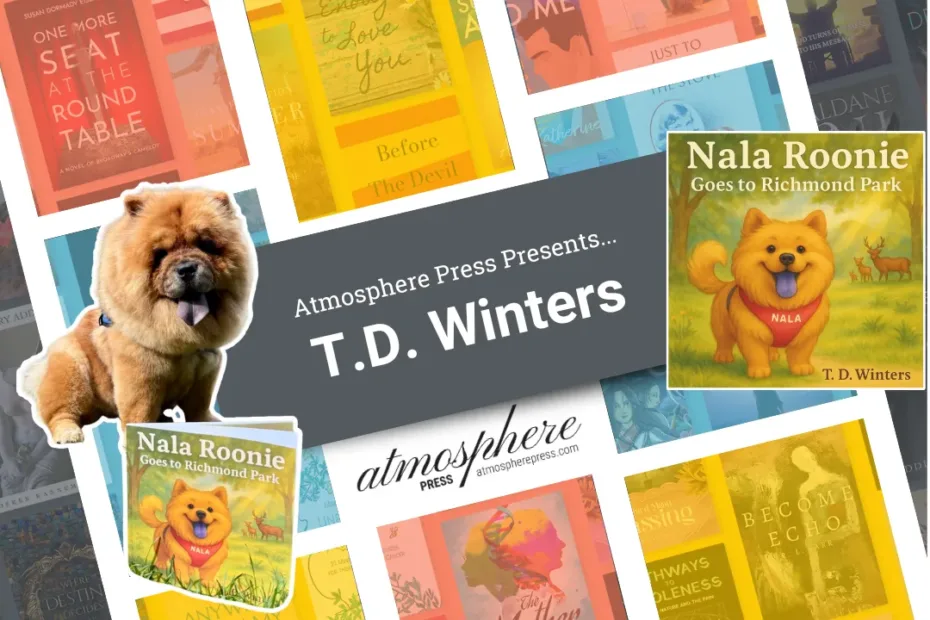An Interview with T.D. Winters

T.D. Winters is the creative voice behind the Nala Roonie Adventures. Working together with Vallace Studio in London, they blend rhyme, illustration, and original music to craft stories that celebrate mindfulness, curiosity, courage, and kindness. The debut picture book, Nala Roonie Goes to Richmond Park, has reached readers around the world, with an audiobook (narrated by Mimi Venki) and a follow-up adventure currently being written and illustrated. Proudly independent, Vallace Studio remains dedicated to preserving its authentic, inclusive voice and nurturing creativity that is heart-centred. Learn more at nalaroonie.com.
What inspired you to start writing this book?
Nala Roonie Goes to Richmond Park was inspired by T.D. Winters’ Chow Chow puppy, Nala, who interacted with busy London with caution and nervousness. In a big city, even small things can feel enormous: stepping onto a bus, crossing a road, meeting a new friend. Children often stop in the street to meet her; there’s something about her lion-like appearance and fluffy cosiness that draws them in.
We noticed how Nala’s worries mirrored those of children trying to navigate a busy world. We often get pets to ease our own anxieties but forget they, too, have worries and fears. Writing this story became a way of exploring that shared experience, finding courage in the small moments and compassion in the uncertain ones.
For T. D. Winters, who has written poetry as a hobby since adolescence, it became an uplifting way to channel that creative energy into something rhythmic and joyful. What began as a creative outlet slowly evolved into a loving, collaborative project built around curiosity, empathy, and everyday bravery.
We also wanted to create inclusive stories that reflect modern families, particularly in big cities like London, different yet full of the same excitement, love, and laughter. Representation matters and we hope every child sees something familiar and reassuring in Nala’s world.
At the heart of it all sits our heartfelt storytelling philosophy: feelings first, learning with love, adventure with heart, and soft power, reminding children that emotions aren’t flaws, that learning together builds courage, and that true bravery is always kind often coupled with curiosity.
Tell us the story of your book’s current title. Was it easy to find, or did it take forever?
The title came naturally. After Nala’s many walks through Richmond Park, we saw her come to life, overcoming fear and enjoying nature, surrounded by deer, horses, open skies, and spring sunlight. That moment became the seed for a whole series: Nala Roonie Goes to… followed by where her adventures lead next (somewhere in London again, perhaps!). It’s been touching to see how readers across the world have embraced her first outing, proving that kindness, curiosity, and courage resonate far beyond a fluffy dog in a London park!
Describe your dream book cover.
Our dream cover was always vivid in our minds: to create a sense of oneness between nature and the city, which we believe is incredibly important for young children. We combined creative writing and drawing supported by digital tools. We wanted it to feel warm, imperfect, and full of life, something that looked handcrafted but not generic or corporate. It’s the kind of cover we hope a child will reach for instinctively, feeling safe before they’ve even turned the first page.
If your book had a soundtrack, what are some songs that would be on it?
It already does! We composed and recorded our own title track using real instruments and plenty of laughter between takes. It began organically, singing to Nala Roonie during playtime until the melody became quite catchy. We expanded it into a full jingle which we hope will be just as memorable for children as it is for us.
What books are you reading (for research or comfort) as you continue the writing process?
We often return to Winnie-the-Pooh and Paddington, stories that balance humour, sincerity and emotional storytelling. We’ve also spent time researching the Chow Chow breed (beyond our own direct experience) and Richmond Park itself, learning about its history and wildlife so we could include educational touches for children and parents. That research grew into an interactive learning experience for children: the Nala Knows page, a section of facts and local notes designed to make learning fun.
What other professions have you worked in? What’s something about you that your readers wouldn’t know?
T.D. Winters is a professional, whose day-to-day working world is very different, and this book offers an outlet for her creativity. Created in the quieter hours around day-to-day work, every element from rhyme to illustration to music is produced in-house at Vallace Studio, which keeps the storytelling close to the heart and allows us to protect its handmade and authentic feel.
Who/what made you want to write? Was there a particular person, or particular writers/works/art forms that influenced you?
We’re inspired by creators who find beauty and presence in small moments such as A.A. Milne, Julia Donaldson, Rupi Kaur, and Michael Bond, writers who remind us that gentleness can be powerful. Music and visual art influence us just as much. We see storytelling as rhythm and pictures working together; the tone of the poetry shapes the illustrations, and the lighting shifts to match the rhythm of the verse. Towards the end of Nala Roonie Goes to Richmond Park, as the day winds down, the artwork softens to mirror the slowing rhythm of the text. That harmony between art and rhythm defines how we hope people see the book: creative, layered, and one with nature.
Where is your favorite place to write?
Our favourite place is our Vallace Studio workspace, a small creative hub where words, art, and music meet. There are sketches pinned up, mugs of tea on the table, and one very fluffy editor asleep beneath it. Nala often dozes by our feet, her gentle snoring keeping time with our typing. It’s a calm, collaborative space that holds laughter, focus, and the kind of warmth we hope readers can feel on every page.
What advice would you give your past self at the start of your writing journey?
It might sound cliche, but trust the process. Creativity doesn’t need to compete with the pace of the world. We’d tell our past selves that independent publishing, though challenging, offers the chance to experiment, to refine, to create, and to let intuition lead. Every word, drawing, and note takes time and that’s what gives the story heart.
What’s one thing you hope sticks with readers after they finish your book?
That courage can be quiet. Sometimes it’s a dog hesitating at the door, or a child taking their first bus ride. We hope readers, young and old, see a bit of themselves in Nala’s small acts of bravery and learn that it’s okay to be anxious and to keep trying anyway.
Nala is a real dog who gets stopped in the street all the time; children sense her sensitivity immediately. We never expected the story to reach an international audience, but it’s shown us how universal those little emotional truths can be. We now have an audiobook (narrated by Mimi Venki) and Nala’s next adventure in development, thanks to the encouragement and support of our readers around the world.
Creating the Nala Roonie character has also taught us a lot about ourselves. Stepping into a new creative field was both exciting and humbling. It reminded us to slow down, look after one another, and celebrate the quiet moments. More than anything, it’s reaffirmed our belief that small things make the biggest difference.
The message that we are trying to relay is for children to be able to find peace and presence in what can often be a very chaotic and noisy city. The core of this message is around mindfulness and kindness, which we have articulated through the experiences of Nala in the city. Our hope is that the heartfelt storytelling philosophy of feelings first, learning with love, adventure with heart, and soft power. We feel this helps young readers pause, breathe, and find calm curiosity in their own surroundings. Amidst it all, we’ve tried to keep each book interactive, hiding small Easter eggs throughout the pages so children can discover new details with every read, turning mindfulness into playful exploration.
Are you a writer, too? Submit your manuscript to Atmosphere Press.

Atmosphere Press is a selective hybrid publisher founded in 2015 on the principles of Honesty, Transparency, Professionalism, Kindness, and Making Your Book Awesome. Our books have won dozens of awards and sold tens of thousands of copies. If you’re interested in learning more, or seeking publication for your own work, please explore the links below.
